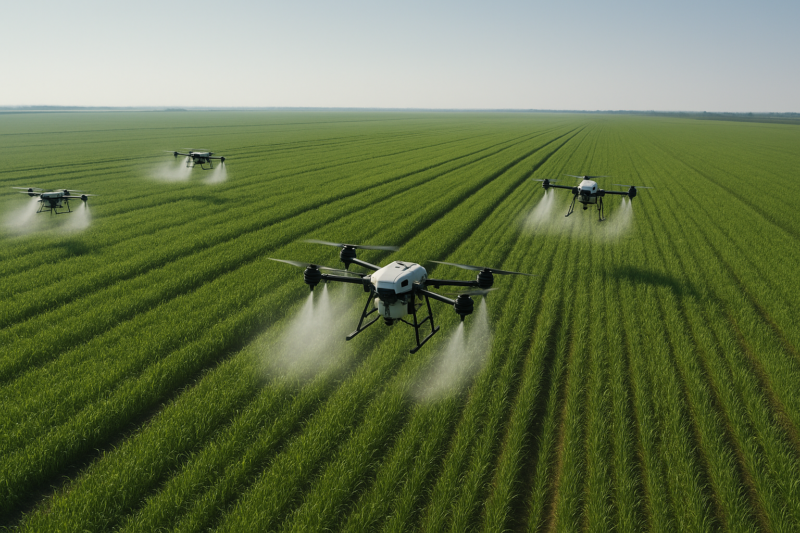Sign up for CleanTechnica’s Weekly Substack for Zach and Scott’s in-depth analyses and high level summaries, sign up for our daily newsletter, and/or follow us on Google News!

A couple of years ago, while exploring the potential of agricultural drone technology through the lens of Hylio’s innovative spraying systems, I found myself wondering if these small machines could shift the massive inertia of global agriculture. At the time, Hylio was doing intriguing work, showcasing promising results with farmers in the United States and Latin America, but the drone sector felt niche at the time, although with great promise.
Fast forward to today, and that promise is being realized—drone spraying has not only reached scale but has arguably become a transformative technology reshaping farming economics globally. Nothing highlights this revolution more vividly than DJI’s remarkable assertion: their agricultural drones now spray one-third of all farmland in China.
DJI, known globally as the leading consumer drone giant, quietly built one of the world’s most significant agricultural drone fleets, deploying over 300,000 units globally as of late 2023. The magnitude of DJI’s claim—that fully one-third of China’s agricultural land is regularly sprayed using their drones—is astonishing yet credible. China, after all, has been a pioneer in embracing and scaling drone technology in farming, actively subsidizing drone purchases for farmers, thereby creating a large, eager market for agricultural automation.
The economics underpinning this shift toward drones are compelling. Traditional agricultural tractors, essential but expensive tools in farming, can easily range in price from $100,000 for simpler units to upwards of $700,000 for sophisticated, high-end precision agriculture machines. These tractors are capital-intensive, fuel-consuming, require considerable ongoing maintenance, and still depend heavily on human operators. By comparison, agricultural spray drones have become remarkably affordable, typically priced between $5,000 and $15,000 per drone. Beyond their low upfront costs, drones dramatically reduce operational expenses by lowering fuel use to near zero, sharply reducing chemical inputs through precise application, and cutting labor requirements substantially.
The scale of savings becomes clear when examining actual farm-level case studies. Farmers transitioning from traditional spraying methods—whether tractor-mounted rigs or manned crop-dusting aircraft—regularly report savings of around 30% per hectare, factoring in reduced chemical volumes, lowered labor costs, and minimal fuel and maintenance. According to field data from drone manufacturers, drone spraying reduces chemical use by roughly 25–30% per hectare due to precise GPS-guided spray patterns. Labor efficiency gains are equally significant; whereas conventional spraying typically demands multiple operators, drone swarms managed by a single technician can cover hundreds of hectares in a single day.
Per recent field trials highlighted by DJI and independent agricultural studies, drones now regularly outperform traditional spraying methods in accuracy, efficiency, and consistency. The precision guidance systems employed by modern agricultural drones offer spraying accuracy within just a few centimeters, minimizing waste and maximizing effectiveness. Farmers who previously relied on manual spraying methods or tractor-based applications have experienced productivity leaps as drones can navigate difficult terrains, steep orchards, and fragmented fields more safely and reliably. This capability unlocks not only substantial economic benefits but environmental ones as well, significantly reducing agrochemical runoff and enhancing soil health by reducing compaction from heavy machinery.
In technological terms, agricultural drones have matured rapidly. Payload capacities have grown substantially; modern spray drones routinely carry payloads of 30–75 kilograms, enabling extensive coverage between refills. Battery technology, often a limiting factor in drone flight duration, has improved considerably. Today’s commercial spray drones commonly fly missions lasting 20–30 minutes per battery set—enough to treat several hectares before requiring a battery swap or recharge. Artificial intelligence and advanced mapping software further refine performance, automating flight patterns and optimizing chemical delivery according to real-time plant health data.
China’s leadership in this field is no coincidence. The Chinese government’s early and aggressive promotion of drone use in agriculture facilitated rapid domestic industry growth. DJI and its main domestic competitor, XAG, dominate not only the Chinese market but increasingly influence global agricultural practices. These firms have capitalized on favorable regulations and subsidies designed to push agricultural mechanization and automation, creating a blueprint other countries are now beginning to replicate. While North America and Europe initially approached agricultural drone adoption cautiously due to regulatory hurdles and safety concerns, both regions have seen significant progress recently. The Federal Aviation Administration (FAA) in the United States, for instance, has streamlined approvals for drone spraying operations, signaling broader acceptance and paving the way for American farmers to adopt drone spraying widely.
Cost advantages come in two flavors with drone spraying. The reduction in product requirements for the same crop output is a big one. But another one is reduced soil compaction. Studies in the US midwest and elsewhere find reduced soil compaction, a key challenge with heavy machinery spraying. One study found 55% crop increases, while the average is in the 25% to 35% range.
Environmental advantages are another critical factor driving adoption. Drones’ precision applications reduce chemical use dramatically, translating directly into healthier ecosystems, cleaner water supplies, and reduced soil degradation. Additionally, their battery-driven propulsion sharply lowers greenhouse gas emissions compared to fossil-fuel-powered tractors or aircraft. DJI’s analysis shows a 25.72 million ton CO₂e reduction from drone use (equivalent to planting 1.2 billion trees). Water savings are also notable: drones’ efficient spray and no-till operation saved 210 million metric tons of water in global operations to date (important in arid regions).
Despite the explosive growth, challenges remain. Drone adoption is not without obstacles; farmers in some regions still face regulatory uncertainty, especially concerning drone operation beyond visual line-of-sight or over densely populated areas. The complexity of pilot training and drone maintenance requirements presents barriers, though these are diminishing rapidly as drone manufacturers expand training programs. Additionally, battery limitations, while improved, continue to restrict drone range, necessitating frequent battery swaps or charges on larger farms. Yet, these challenges pale in comparison to the transformative benefits already demonstrated at scale.
Reflecting back on my initial exploration of drone spraying through Hylio’s early successes, it’s clear the technology has met my expectations. DJI’s claim of covering one-third of China’s farmland marks a genuine tipping point, not just for drone adoption but for the entire agricultural sector globally. As regulatory environments evolve and technology continues advancing, it seems inevitable that agricultural drone use will become ubiquitous rather than exceptional, reshaping farm economics and environmental sustainability worldwide, just as I expected.
The trajectory we’re seeing now aligns closely with other historically disruptive agricultural technologies—like GPS-guided tractors or genetically modified crops—that began as novel experiments and ended as industry standards. If current growth patterns continue—and there is little reason to doubt they will—by 2035, drone spraying could easily become standard practice on the majority of farms worldwide, reshaping agriculture profoundly and permanently.
Whether you have solar power or not, please complete our latest solar power survey.
Have a tip for CleanTechnica? Want to advertise? Want to suggest a guest for our CleanTech Talk podcast? Contact us here.
Sign up for our daily newsletter for 15 new cleantech stories a day. Or sign up for our weekly one on top stories of the week if daily is too frequent.
CleanTechnica uses affiliate links. See our policy here.
CleanTechnica’s Comment Policy




